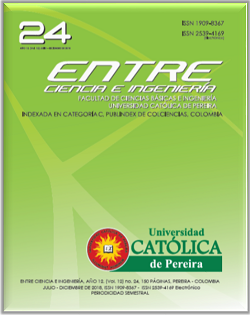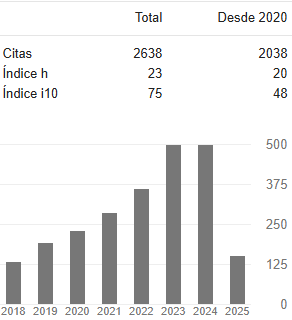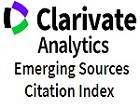Una aproximación a la realidad aumentada y sus aplicaciones quirúrgicas
DOI:
https://doi.org/10.31908/19098367.3811Palabras clave:
cirugía laparo scópica, realidad aumentada, realidad virtual, simulación quirúrgica.Resumen
Este artículo muestra un panorama generalde las temáticas de investigación y desarrollo en el área de lasimulación en el entrenamiento y apoyo de cirugías usando latecnología de Realidad Aumentada, la cual se caracteriza porenriquecer la percepción sensorial adicionando contenido virtualsobre la percepción de realidad. Inicialmente, se describen lossistemas de guía de ayuda para cirugía, luego, los principalesavances en simuladores usando como base de comparaciónlos simuladores de Realidad Virtual (VR) y, para fi nalizar, serealiza una exposición de aplicaciones de Realidad Aumentada(AR) en la cirugía haciendo énfasis en las cirugías mínimamenteinvasivas. En esta revisión se muestra el rol de la simulación enel entrenamiento quirúrgico y en la cirugía guiada, así como laventaja comparativa de los entrenadores de Realidad Aumentada(AR) sobre los de Realidad Virtual (VR).
Descargas
Referencias
Nicolau, S., Soler, L., Mutter, D. and Marescaux, J., “Augmentedreality in laparoscopic surgical oncology.” Surgical oncology, vol.20, no. 3, pp. 189-201, 2011.
Yu, H. Y., Hevelone, N. D., Lipsitz, S. R., Kowalczyk, K. J. and Hu, J. C., “Use, costs and comparative effectiveness of robotic assisted, laparoscopic and open urological surgery”, The Journal of urology, 187(4), pp. 1392-1399, 2012.
Miccoli, P., Bellantone, R., Mourad, M., Walz, M., Raffaelli, M. and Berti, P. “Minimally invasive video-assisted thyroidectomy: multiinstitutional experience,” World journal of surgery, vol. 26, no. 8, pp. 972–975, 2002.
Van der Pas, M., Haglind, E., Cuesta, M. A., F ̈urst, A., Lacy, A.M., Hop, W. C., Bonjer, H. J., Cancer Laparoscopic or Open Resection II(COLOR II) Study Group, et al., “Laparoscopic versus open surgery for rectal cancer (color ii): short-term outcomes of a randomised, phase 3 trial”, The lancet oncology, vol. 14, no. 3, pp. 210–218, 2013.
Pugliese, R. and Bailey, M., “Laparoscopic surgery: the need of training centres to spread knowledge,” Journal of Medicine and The Person, vol. 6, no. 4, pp. 160–163, 2008.
Marescaux, J. and Diana, M., “Next step in minimally invasive surgery:hybrid image-guided surgery”, Journal of pediatric surgery, vol. 50, no. 1, pp. 30–36, 2015.
Jamali, S. S., Shiratuddin, M. F., Wong, K. W. and Oskam, C. L.,“Utilising mobile-augmented reality for learning human anatomy,” Procedia-Social and Behavioral Sciences, vol. 197, pp. 659–668,2015.
Han, P. and Zhao, G., “Cad-based 3d objects recognition in monocular images for mobile augmented reality”, Computers & Graphics, vol 50, pp. 36-46, 2015.
Wen, R., Tay, W. -L., Nguyen, B. P., Chang, C. -B. and Chui, C. -K., “Hand gesture guided robot-assisted surgery based on a direct augmented reality interface”, Computer methods and programs in biomedicine, vol. 116, no. 2, pp. 68–80, 2014.
Guzmán, D. E. and Albán O. A., “Software para la práctica de larobótica quirúrgica”, Ingeniería y Universidad, vol. 19, no. 1, pp. 7–26, 2015.
Moreno, M. R., Moraes, T. F., Amorim, P. H., da Silva, J. V. L. and Rodríguez, C. A., “Virtual open source environment for training and simulation of laparoscopic surgery”, in XII Workshop de Informática Médica (WIM’2012)-XXXII Congresso da Sociedade Brasileira de Computaçao, pp. 1–4, 2012.
Lacy, de A. M., Rattner, D. W., Adelsdorfer, C., Tasende, M.M., Fernández, M., Delgado, S., Sylla, P. and Martínez-Palli, G., “Transanal natural orifice transluminal endoscopic surgery (notes) rectal resection: “down-to-up” total mesorectal excision (tme) shortterm out comes in the first 20 cases”, Surgical endoscopy, vol. 27, no. 9, pp. 3165–3172, 2013.
Autorino, R., Cadeddu, J. A., Desai, M. M., Gettman, M., Gill, I. S.,Kavoussi, L. R., Lima, E., Montorsi, F., Richstone, L., Stolzenburg, L. U., et al., “Laparoendoscopic single-site and natural orifice transluminal endoscopic surgery in urology: a critical analysis of the literature”, European urology, vol. 59, no. 1, pp. 26–45, 2011.
Rané, A. and Rao, P., “Single-port-access nephrectomy and other laparoscopic urologic procedures using a novel laparoscopic port (r-port)”, Urology, vol. 72, no. 2, pp. 260–263, 2008.
Autorino, R., Kaouk, J. H., Yakoubi, R., Rha, K. H., Stein, R. J., White, W. M., Stolzenburg, J. -U., Cindolo, L., Liatsikos, RaisBahrami, S., et al., “Urological laparoendoscopic single site surgery: multi-institutional analysis of risk factors for conversion and postoperative complications”, The Journal of urology, vol. 187, no. 6, pp. 1989–1994, 2012.
Duchene, D. A., Moinzadeh, A., Gill, I. S., Clayman, R. V. andWinfield, H. N., “Survey of residency training in laparoscopic and robotic surgery”, The Journal of urology, vol. 176, no. 5, pp. 2158–2167, 2006.
Benítez, P. A., “Desarrollo de un sistema de realidad aumentada para entrenamiento en planificación neuroquirúrgica”, tesis para optar al grado de magíster en ciencias de la ingeniería electrónica con mención en computadores, Universidad técnica Federico Santa María Departamento de Electrónica Valparaíso, Chile, 2014.
Mosso, J. L., “Propuesta de una clasificación quirúrgica”, Cirugía y Cirujanos, vol 71, pp. 492-495, 2003.
Melkent, T., Foley, K. T., Estes, B. T. and Chaudoin, J., “Image guided spinal surgery guide system and method for use thereof”, U.S. Patent 8,105,339, issued January 31, 2012.
Nguyen, Q. T., Tsien. R. Y., “Fluorescence-guided surgery with live molecular navigation [mdash] a new cutting edge”, Nature Reviews Cancer 13, no. 9, pp. 653-662, 2013.
Huang, D., He, D. -m, Yang, C., Chen, M. -j., Zhou, Q. and Dong, M.-j., “Computer-assisted local resection for exostosis osteochondroma of the mandibular condyle”, Journal of Craniofacial Surgery, 24, no. 4, pp. e446-e449, 2013.
Vercruyssen, M., Laleman, I., Jacobs, R. and Quirynen, M., “Computer-supported implant planning and guided surgery: a narrative review”, Clinical oral implants research, vol. 26, no. S11, pp. 69–76, 2015.
Torresanto, di V. M., Milinkovic, I., Torsello, F. and Cordaro, L., “Cirugía implantológica sin colgajo, asistida por ordenador, en pacientes edéntulos de edad avanzada: seguimiento de 2 años”, Quintessence: Publicación internacional de odontología, vol. 2, no. 5, pp. 318–329, 2014.
Lasserre, F. and Auber, N., “Navigation chirurgicale associée à l’imagerie per-opératoire”, IRBM news, vol. 30, no. 4, pp. 15–29, 2009.
Nguyen, Y., Miroir, M., Vellin, J. -F, Mazalaigue, S., Bensimon, J. -L, Bernardeschi, D., Ferrary, E., Sterkers, O. and Grayeli, A. B., “Minimally invasive computer-assisted approach for cochlear implantation a human temporal bone study”, Surgical innovation, vol. 18, no. 3, pp. 259–267, 2011.
Bernardeschi, D., Nguyen, Y., Villepelet, A., Ferrary, E., Mazalaigue, S., Kalamarides, M. and Sterkers, O., “Use of bone anchoring device in electromagnetic computer-assisted navigation in lateral skull base surgery”, Acta oto-laryngologica, vol. 133, no. 10, pp. 1047–1052, 2013.
Collin, M., Bernardeschi, D., Cazals-Hatem, D. and Sterkers, O., “Menin-gioma of geniculate ganglion: case report and review of the literature”, Acta oto-laryngologica, vol. 133, no. 3, pp. 228–232, 2013.
Prnasky J. “ROBODOC-surgical robot success story”, Industrial Robot: An International Journal, vol 24, no 3, pp 231-233, 1997.
Molloy, S., Aftab, S., Patel, A., Butler, J., Balaji, V., Wilson, L. and Lee, R., “The british experience of pedicle screw insertion using the o-arm imaging system and stealth station navigation system”, Bone & Joint Journal Orthopaedic Proceedings Supplement, vol. 96, no. SUPP 15, pp. 30–30, 2014.
Xiaojun C., “Development of a surgical navigation system based on augmented reality”, Journal of Biomedical Informatics, no. 55, pp. 124-131, 2015.
Gerbino, G., Zavattero, E. Berrone, M. and Berrone, S., “Management of needle breakage using intraoperative navigation following inferior alveolar nerve block”, Journal of Oral and Maxillofacial Surgery, vol. 71, no. 11, pp. 1819–1824, 2013.
Mezger, U., Jendrewski, C. and Bartels, M., “Navigation in surgery,” Langenbeck’s Archives of Surgery, vol. 398, no. 4, pp. 501–514, 2013.
Kantelhardt, S. R., Greke, C., Keric, N., Vollmer, F., Thiemann, I. and Giese, A., “Image guidance for transcranial doppler ultrasonography”, Neurosurgery, vol. 68, pp. ons257–ons266, 2011.
García, O., Olvera, H. and Beltrán, J., “Telemedicina y cirugía robótica en ginecología”, Ginecol Obstet Mex, vol. 76, no. 3, pp. 161–166, 2008.
Tholey, G., Desai, J. P. and Castellanos, A. E., “Force feedback plays a significant role in minimally invasive surgery: results and analysis”, Annals of surgery, vol. 241, no. 1, p. 102, 2005.
Robinson, W. P., Schanzer, A., Cutler, B. S., Baril, D. T., Larkin, A. C., Eslami, M. H., Arous, E. J. and Messina, L. M., “A randomized comparison of a 3-week and 6-week vascular surgery simulation course on junior surgical resident performance of an end-to-side anastomosis”, Journal of vascular surgery, vol. 56, no. 6, pp. 1771– 1781, 2012.
Perrenot, C., Perez, M., Tran, N., Jehl, J. -P., Felblinger, J., Bresler, L. and Hubert, J., “The virtual reality simulator dv-trainer is a valid assessment tool for robotic surgical skills”, Surgical endoscopy, vol. 26, no. 9, pp. 2587–2593, 2012.
Jakimowicz, J. J. and Jakimowicz, C. M., “Simulación en cirugía, ¿dónde estamos y a dónde llegaremos?”, Cir Cir, vol. 79, pp. 44–49, 2011.
Sonja, N. Buzink, Richard H.M. Goossens, Huib De Ridder & Jack J. Jakimowicz (2010) Training of basic laparoscopy skills on SimSurgery SEP, Minimally Invasive Therapy & Allied Technologies, vol.19, no. 1, pp. 35-41, 2010.
Bric, D., Lumbard, D. C., Frelich, M. J. and Gould, J. C., “Current state of virtual reality simulation in robotic surgery training: a review”, Surgical endoscopy, vol. 30, no. 6, pp. 1–10, 2015.
Guthart, G. and Salisbury, J., The Intuitive/sup TM/telesurgery system: overview and application, Robotics and Automation, 2000, ICRA’00 IEEE International Conference, vol. 1, pp. 618-621, 2000.
Perrenot, C., Perez, M., Tran, N., Jehl, J., Felblinger, J., Bresler, L., and Hubert, J., The virtual reality simulator dv-trainerR© is a valid assessment tool for robotic surgical skills. Surgical endoscopy, vol. 26, no. 9, pp. 2587–2593, 2012.
Hung, A. J., Jayaratna, I. S., Teruya, K., Desai, M.M., Gill, I. S. and Goh, A. C., “Comparative assessment of three standardized robotic surgery training methods”, BJU international, vol. 112, no. 6, pp. 864–871, 2013.
Simulated Surgical Systems: Products”, Simulated Surgical Systems, http://www.simulatedsurgicals.com/ross2.html, Accessed: 28- Sep- 2018.
Gavazzi, A., Bahsoun, Van Haute, W. V., Ahmed, K., Elhage, O., Jaye, P., Khan, M. S. and Dasgupta, P., “Face, content and construct validity of a virtual reality simulator for robotic surgery (SEP Robot)”. Annals of the Royal College of Surgeons of England, vol. 93, no. 2, pp. 152-156, 2011.
Abboudi, H., Khan, M., Aboumarzouk, O., K. Guru, A., Challacombe, B., Dasgupta, P., and Ahmed, K., “Current status of validation for roboticsurgery simulators–a systematic review,”BJU international, vol. 111, no. 2, pp. 194–205, 2013.
Botden, S., Buzink, S., Schijven, M., and Jakimowicz, J., “Promisaugmented reality training of laparoscopic procedures face validity,”Simulation in healthcare, vol. 3, no. 2, pp. 97–102, 2008.
Xiao, D., Jakimowicz, J. J., Albayrak, A., Buzink, S. N., Botden, S. M. and Goossens, R. H., “Face, content, and construct validity of a novel portable ergonomic simulator for basic laparoscopic skills”, Journal of surgical education, vol. 71, no. 1, pp. 65–72, 2014.
Kipper, G. and Rampolla, J. Augmented Reality: an emerging technologies guide to AR. Elsevier, 2012. [50] Kirkman, M., Ahmed, M., Albert, A., Wilson, M., Nandi, D., and Sevdalis, N., “The use of simulation in neurosurgical education and training: A systematic review,”Journal of neurosurgery, vol. 121, no. 2, pp. 228–246,2014.
AlZhrani, G., AlOtaibi, F., Azarnoush, H., Winkler-Schwartz, A., Sabbagh, A., Lajoie, S. and Del Maestro, R., “Ms-05 utilizing a virtual reality simulator,neurotouch, to determine proficiency performance benchmarks for resection of simulated brain tumors”, Neuro-Oncology, vol. 16, no. suppl 5, pp. 127–128, 2014.
Azarnoush, H., Alzhrani, G., Winkler-Schwartz, A., Alotaibi, F., Gelinas-Phaneuf, N., Pazos, V., Choudhury, N., Fares, J., DiRaddo, R. and Del Maestro, R. F., “Neurosurgical virtual reality simulation metrics to assess psychomotor skills during brain tumor resection”, International journal of computer assisted radiology and surgery, vol. 10, no. 5, pp. 603–618, 2014.
Cabrilo, I., Schaller, K. and Bijlenga, P., “Augmented realityassisted bypass surgery: Embracing minimal invasiveness”, World neurosurgery, vol. 83, no. 4, pp. 596–602, 2015.
Alotaibi, F. E., AlZhrani, G. A., Mullah, M.A., Sabbagh, A. J., Azarnoush, H., Winkler-Schwartz, A. and Del Maestro, R. F., “Assessing bimanual performance in brain tumor resection with neurotouch, a virtual reality simulator”, Operative Neurosurgery, vol. 11, no. 1, pp. 89–98, 2015.
Alaraj, A, Luciano, C. J., Bailey, D. P., Elsenousi, A., Roitberg, B. Z., Bernardo, A., Banerjee, P. P. and Charbel, F. T., “Virtual reality cerebral aneurysm clipping simulation with real-time haptic feedback”, Operative Neurosurgery, vol. 11, no. 1, pp. 52–58, 2015.
Yudkowsky, R., Luciano, C., Banerjee, P., Schwartz, A., Alaraj, A., Lemole Jr, G, F., Charbel, F., Smith, K., Rizzi, S., Byrne, R., et al., “Practice on an augmented reality/haptic simulator and library of virtual brains improves residents’ ability to perform a ventriculostomy”, Simulation in Healthcare, vol. 8, no. 1, pp. 25– 31, 2013.
Glossop, N., Wedlake, C., Moore, J., Peters, T. and Wang, Z., Laser projection augmented reality system for computer assisted surgery. In Medical Image Computing and Computer-Assisted InterventionMICCAI 2003 (pp. 239-246). Springer Berlin Heidelberg, 2003.
Abe, Y., Sato, S., Kato, K., Hyakumachi, T., Yanagibashi, Y., Ito, M. and Abumi, K., “A novel 3d guidance system using augmented reality for percutaneous vertebroplasty: technical note”, Journal of Neurosurgery: Spine, vol. 19, no. 4, pp. 492–501, 2013.
Shenai, M. B., Dillavou, M., Shum, C., Ross, D., Tubbs, R. S., Shih, A. and Guthrie, B. L., “Virtual interactive presence and augmented reality (vipar) for remote surgical assistance”, Neurosurgery, vol. 68, pp. ons200–ons207, 2011.
Ungi, T., Yeo, C. T., Paweena, U., McGraw, R. C., Fichtinger, G., et al., “Augmented reality needle guidance improves facet joint injection training”, in SPIE Medical Imaging, pp. 79642E–79642E, International Society for Optics and Photonics, 2011.
Harris, A., Bello, F. and Kneebone, R., “Simulation and training in minimal access surgery”, in Training in Minimal Access Surgery, pp. 35–47, Springer, 2015.
Maestro AR - Mimic Simulation: 2018. http://mimicsimulation. com/maestro-ar/. Accessed: 2018- 09- 28.
Simulated Surgical Systems introduces HoST: 2018. http://www. simulatedsurgicals.com/host/. Accessed: 2018- 09- 28.
Polhemus Markets - Healthcare: 2018. https://polhemus.com/ markets/healthcare/. Accessed: 2018- 09- 28.
Pagador, J. B., Sánchez, L., Sánchez, J., Bustos, P., Moreno, J. and Sánchez-Margallo, F. M., “Augmented reality haptic (arh): an approach of electromagnetic tracking in minimally invasive surgery”, International journal of computer assisted radiology and surgery, vol. 6, no. 2, pp. 257–263, 2011.
Edgcumbe, P., Pratt, P., Yang, G -Z, Nguan, C. and Rohling, R., “Pico lantern: Surface reconstruction and augmented reality in laparoscopic surgery using a pick-up laser projector”, Medical Image Analysis, vol. 25, no. 1, pp. 95–102, 2015.
Ukimura, O. and Gill, I. S., “Imaging-assisted endoscopic surgery: Cleveland clinic experience”, Journal of Endourology, vol. 22, no. 4, pp. 803–810, 2008. [68] Bruellmann, D., Tjaden, H., Schwanecke, U. and Barth, P., “An optimized video system for augmented reality in endodontics: a feasibility study”, Clinical oral investigations, vol. 17, no. 2, pp. 441–448, 2013.
Okamoto, T., Onda, S., Yasuda, J., Yanaga, K., Suzuki, N. andHattori, A., “Navigation surgery using an augmented reality forpancreatectomy”, Digestive surgery, vol. 32, no. 2, pp. 117–123,2015.
Gutiérrez, E. M., “Sistema de realidad aumentada para la interaccióncon el instrumental en el procedimiento de acceso venoso central”,Informe final de auxiliar de Investigación para optar al Título deIngeniero en Mecatrónica, Universidad Militar Nueva Granada,Colombia, 2015.
De Paolis, L. T., Ricciardi, F., Dragoni, A. F. and Aloisio, G., “Anaugmented reality application for the radio frequency ablation ofthe liver tumors”, in Computational Science and Its ApplicationsICCSA, pp. 572–581, Springer, 2011.
Pauly, O., Diotte, B., Fallavollita, P., Weidert, S., Euler, E. andNavab, N., “Machine learning-based augmented reality for improvedsurgical scene understanding”, Computerized Medical Imaging andGraphics, vol. 41, pp. 55–60, 2015.
Folguera, F., Juan, M. C., Herrero, A. and Alexandrescu, L.,“Introducción a una nueva dimensión en la morfología dentaria:Ardental (realidad aumentada dental)”, Gaceta dental: Industria yprofesiones, no. 252, pp. 200–209, 2013.
Lindeque, B. G., Ponce, B. A., Menendez, M. E., Oladeji, L. O.,Fryberger, C. T. and Dantuluri, P. K., “Emerging technology insurgical education: combing in greal-time augmented reality andwearable computing devices”, Orthopedics (Online), vol. 37, no.11, p. 751, 2014.
Sutherland, I. E., “A head-mounted three dimensional display”,in Proceedings of the December 9-11, 1968, fall joint computerconference, part I, pp. 757–764, ACM, 1968.
Taqvi, Z., “Reality and perception: Utilization of many facets ofaugmented reality”, in Artificial Reality and Telexistence (ICAT),23rd International Conference on, pp. 11–12, IEEE, 2013.
Pandya, A., “Augmented reality,” International Journal of Researchin Advance Engineering, vol. 1, no. 1, pp. 10–19, 2015.
Bau, O. and Poupyrev, I., “Revel: tactile feedback technology foraugmented reality”, ACM Transactions on Graphics (TOG), vol. 31,no. 4, p. 89, 2012.
Jeon, S. and Harders, M., “Extending haptic augmented reality:Modulating stiffness during two-point squeezing”, in HapticsSymposium (HAPTICS), 2012 IEEE, pp. 141–146, IEEE, 2012.
Botden, S. M., Buzink, S. N., Schijven, M. P. and Jakimowicz, J.J., “Augmented versus virtual reality laparoscopic simulation: whatis the difference?”, World Journal of Surgery, vol. 31, no. 4, pp.764–772, 2007.
Nomura, T., Mamada, Y., Nakamura, Y., Matsutani, T., Hagiwara,N., Fujita, I., Mizuguchi, Y., Fujikura, T., Miyashita, M. and Uchida,E., “Laparoscopic skill improvement after virtual reality simulatortraining in medical students as assessed by augmented realitysimulator”, Asian journal of endoscopic surgery, vol. 8, no. 4, pp.408–412, 2015.
Yiannakopoulou, E., Nikiteas, N., Perrea, D. and Tsigris, C.,“Virtual reality simulators and training in laparoscopic surgery”,International Journal of Surgery, vol. 13, pp. 60–64, 2015.
Choi, H., Cho, B., Masamune, K., Hashizume, M. and Hong, J., “Aneffective visualization technique for depth perception in augmentedreality-based surgical navigation”, The International Journal ofMedical Robotics and Computer Assisted Surgery, vol. 12, no. 1,pp. 62–72, 2016.
Cotin, S., Delingette, H. and Ayache, N., “A hybrid elastic modelfor real-time cutting, deformations, and force feedback for surgerytraining and simulation”, The Visual Computer, vol. 16, no. 8, pp.437–452, 2000.
Rabbi, I., Ullah, S. and Khan, S. U., “Augmented reality trackingtechniques—a systematic literature”, IOSR Journal of ComputerEngineering (IOSRJCE), vol. 2, no. 2, pp. 23–29, 2012.
Jeon, S., Choi, S. and Harders, M., “10 haptic augmented reality”,Fundamentals of Wearable Computers and Augmented Reality, p.227, 2015.
Descargas
Publicado
Número
Sección
Licencia
Derechos de autor 2019 Entre Ciencia e Ingeniería

Esta obra está bajo una licencia internacional Creative Commons Atribución-NoComercial 4.0.



















